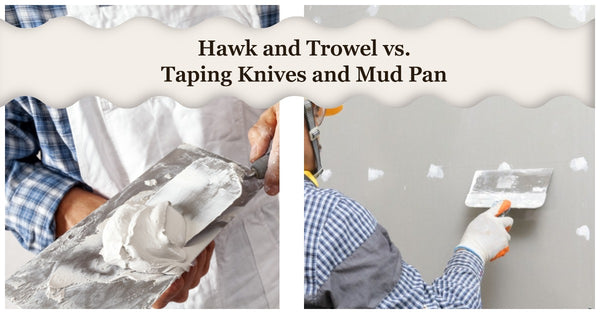Award Winning Service
Award Winning Service


Drywall installation and finishing requires a specialized toolkit. In this post, we will delve into Drywall Hawks, Trowels, Taping Knives, and Mud Pans, examining each tool's origin, function, advantages, disadvantages, and how they are typically used in conjunction with each other in the world of drywall.
A Drywall Hawk is a square platform with a perpendicular handle underneath. It's primarily used as a portable work surface to carry joint compound or plaster as you move along a wall or ceiling. This tool is highly appreciated in the drywall industry for its versatility and enhanced control over the amount of material being used.
The drywall hawk's primary advantage is its mobility, allowing you to carry your joint compound with you as you work. This mobility allows for a smoother workflow and increased efficiency.
However, there is a learning curve associated with effectively using a drywall hawk, particularly when coordinating it with a trowel. The simultaneous use of both tools requires a certain level of skill and experience.
A Drywall Trowel is a flat-bladed tool traditionally used for applying and smoothing plaster. The tool evolved with the drywall industry, and today's trowels are designed specifically for applying and spreading joint compound on drywall sheets. They feature a straight edge for skim coating and a curved edge for seams, enhancing their versatility.
Drywall trowels have a significant advantage in efficiency. The trowel's shape allows the user to push the joint compound along the wall, applying a consistent, even layer of material.
However, the trowel's design can be detrimental in certain situations, particularly for smaller, more precise tasks. Applying joint compound in corners with a trowel, for instance, can lead to accidental damage. Furthermore, mastering a drywall trowel requires practice, making it a more challenging choice for beginners.

Taping Knives are tools used for applying, spreading, and smoothing joint compound. These are traditionally used in conjunction with a mud pan, and they are a staple in the drywall finishing process.
Taping knives are generally easier to handle and are particularly well-suited to beginners in the drywall industry. They allow for precision, making them ideal for tasks such as feathering an edge or working in tight corners.
However, taping knives do have their limitations. They are less effective than trowels for larger jobs due to their limited capacity for joint compound. Using a taping knife also requires more force and energy, as the mud is dragged across the wall rather than being pushed.
Mud Pans are flat-bottomed containers used to hold joint compound during the application process. A drywall pan serves as a tool for carrying drywall mud.
The mud pan's primary advantage is its capacity to hold a substantial amount of joint compound, allowing for a steady workflow. Its straight edges also facilitate the cleaning of taping knives between applications.
The disadvantage is that it is stationary, requiring the user to return to it to reload the taping knife with joint compound, unlike the mobile drywall hawk.
In our observation, the popularity of Drywall Hawks and Trowels versus Taping Knives and Mud Pans can significantly vary by region. It's fascinating to note that in some parts of the world, the Hawk and Trowel method is overwhelmingly favored. Contractors and DIY enthusiasts in these areas appreciate the efficiency and portability that these tools offer, especially for large-scale jobs.
Conversely, in other regions, you might find that hardly anyone uses Hawks and Trowels. Instead, the preference leans towards Taping Knives and Mud Pans. The reason could be attributed to the precision, control, and simplicity that this combination offers, which is particularly appealing to beginners and those performing detailed work.

The graph above was gathered from numerous drywall finishing contractors throughout different regions in the United States. The contractors were asked to rate Hawk & Trowel vs Taping Knife and Mud pan based on four criteria: Efficiency, Precision, Ease of Use, Durability.
However, it's important to remember that there isn't a definitive 'right' or 'wrong' choice when it comes to these tools. Ultimately, the most crucial factor is the quality of the job that gets done. Confidence in your method plays a significant role in achieving a seamless finish. Whether you're a fan of the Hawk and Trowel or you swear by Taping Knives and Mud Pans, the best toolset is the one you can skillfully handle to produce outstanding results. You can shop Drywall Trowels, Hawks, Taping Knives, Mud Pans, and any of your other drywall finishing tool needs at Timothy's Toolbox!
0 of 3 items selected
Leave a comment